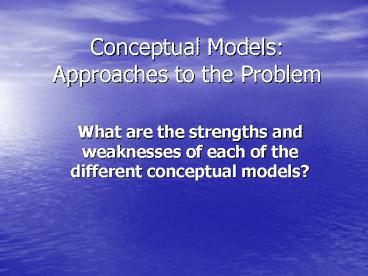Conceptual Models: Approaches to the Problem - PowerPoint PPT Presentation
1 / 13
Title:
Conceptual Models: Approaches to the Problem
Description:
Based on community psychology; social transaction between different individuals across settings. ... Integrates cognitive psychology and behaviorism. ... – PowerPoint PPT presentation
Number of Views:106
Avg rating:3.0/5.0
Title: Conceptual Models: Approaches to the Problem
1
Conceptual Models Approaches to the Problem
- What are the strengths and weaknesses of each of
the different conceptual models?
2
Traditional Conceptual Models
- Psychodynamic Approach (Psychodynamic Model or
Psychoanalytic Model) - Concerned with hypothetical mental mechanisms and
their role in the developmental process. - Once the unconscious motivation of behavior is
understood, the problem will be resolved. - Without understanding of unconscious motivation,
the consequences of the behavior are even more
harmful.
3
Traditional Conceptual Models
- Humanistic Approach (Humanistic Education)
- Self-direction, self-fulfillment, and
self-evaluation. - Ambiguous theoretical underpinnings.
- Postmodernism or Deconstruction in the 1960s and
1970s. - Holistic Education in the 1990s.
- An emphasis on a personal construction of
reality. - Qualitative as opposed to quantitative.
- Life-impact curriculum Meaningful experiences,
and flexibility in acceptance of new realities.
4
Traditional Conceptual Models
- Biogenic Approach
- Human behavior involves neurophysiologic
mechanisms. - Emotional or behavioral disorders result from a
physiological flaw and can be brought under
control through physiological processes. - Brain damage, genetic processes, and metabolic
disorders cannot be treated using the biogenic
approach.
5
Traditional Conceptual Models
- Psychoeducational Approach
- Understanding unconscious motivation and
underlying conflict - Emphasis on realistic demands of everyday
functioning in different settings. - Interventions include helping students be more in
control. - Life Space Interview (LSI) or
- Life Space Crises Intervention (LSCI)
- Students learn to understand their motivations
and the consequences of their actions. They then
develop alternative, acceptable responses.
6
Traditional Conceptual Models
- Ecological Approach (Ecological Model)
- Based on community psychology social transaction
between different individuals across settings. - Intervention emphasizes behavioral and social
learning concepts. - Ecobehavioral Analysisusing natural functional
events to improve instruction and behavior
management skills.
7
Traditional Conceptual Models
- Behavioral Approach (Behavioral Model)
- The problem is the behavior itself.
- Behaviors occur as results of environmental
events. - Intervention Rearranging the antecedent events
to replace maladaptive behaviors with more
adaptive behaviors. - Choose target response, measure it, analyze
environment, and change antecedents to produce
target behavior.
8
Comparing and Eliminating Models
- To compare models you need to understand how each
model - Defines causation,
- Plans intervention, and
- Implements scientific inquiry.
9
Comparing and Eliminating Models
- New Medical Model
- Implements scientific inquiry and practice.
- Supplements behavior management.
- In contrast,
- Postmodernism is not clearly defined and many
believe that it rejects scientific thinking.
10
Developing an Integrated Model
- Selection and use of conceptual models
- We can
- Adopt a single model, or
- Adopt a non-evaluative stance, or
- Focus on hypotheses that have been supported or
refuted by empirical research.
11
Developing an Integrated Model
- The social-cognitive approach
- Explains complex human behavior from a natural
science perspective. - Integrates cognitive psychology and behaviorism.
- Reconceptualizes behavior as a result of the
reciprocal influences of environmental, personal,
and individual behavioral factors.
12
Developing an Integrated Model
- The social-cognitive approach
- Considers the developmental features of behavior.
- Behavior that emphasize social retardation may
differ according to the childs age and his/her
social circumstances - Focuses on Triadic Reciprocality emotional or
behavioral disorders can only be understood in
contexts in which they occur. - Example In order to understand how a teacher can
improve her behavior management, we must consider
how the students affect their teacher.
13
A Structure for Discussion
- To study the characteristics of the emotional or
- behavior disorders we need to study
- The behavior,
- Its assessment,
- Its causes, and
- Its effects in simple and manageable contexts.

